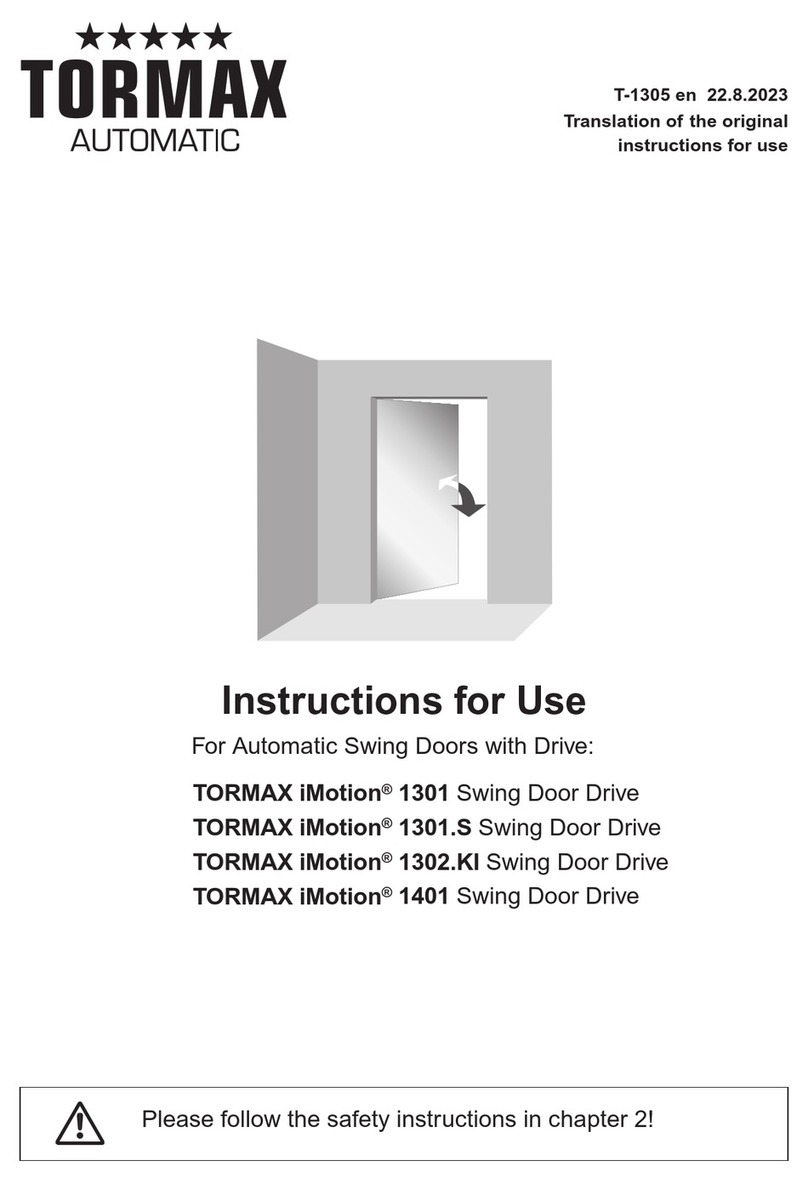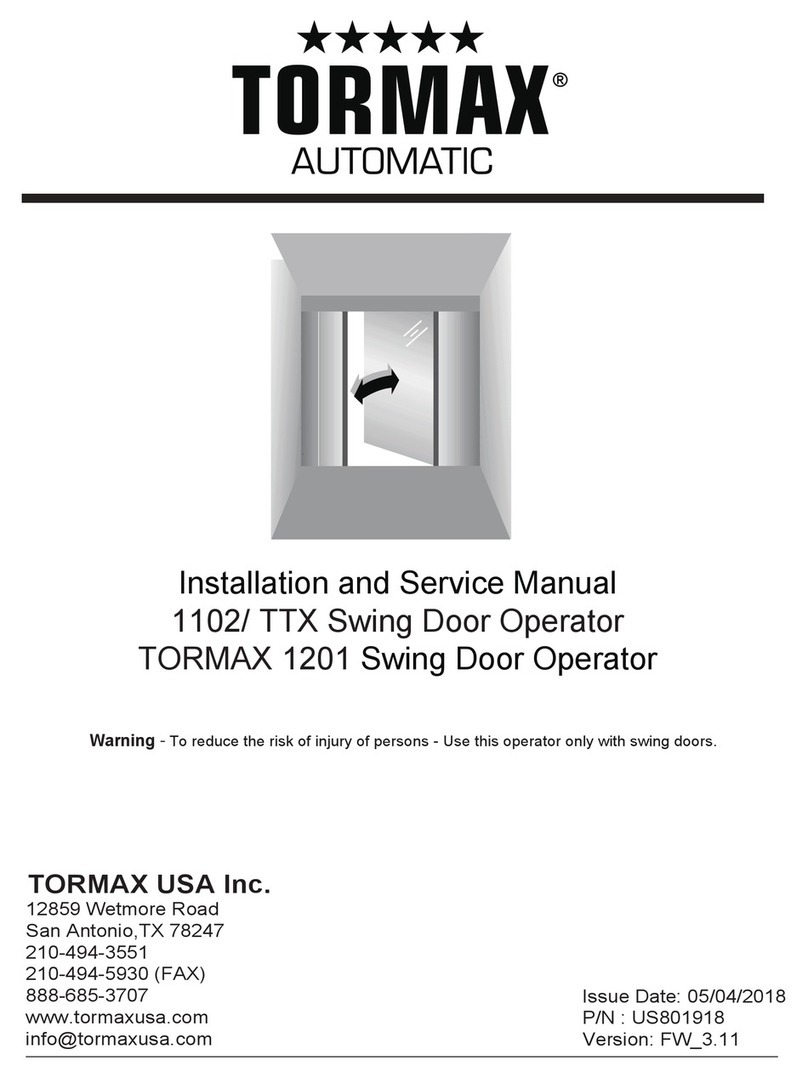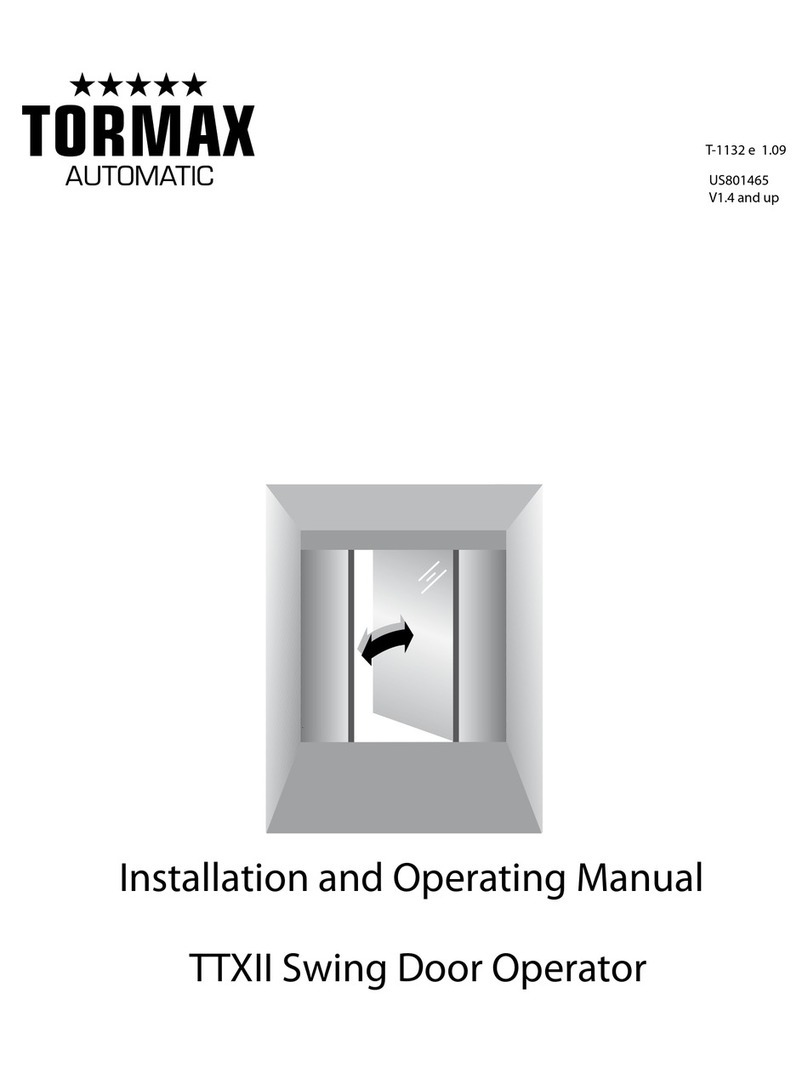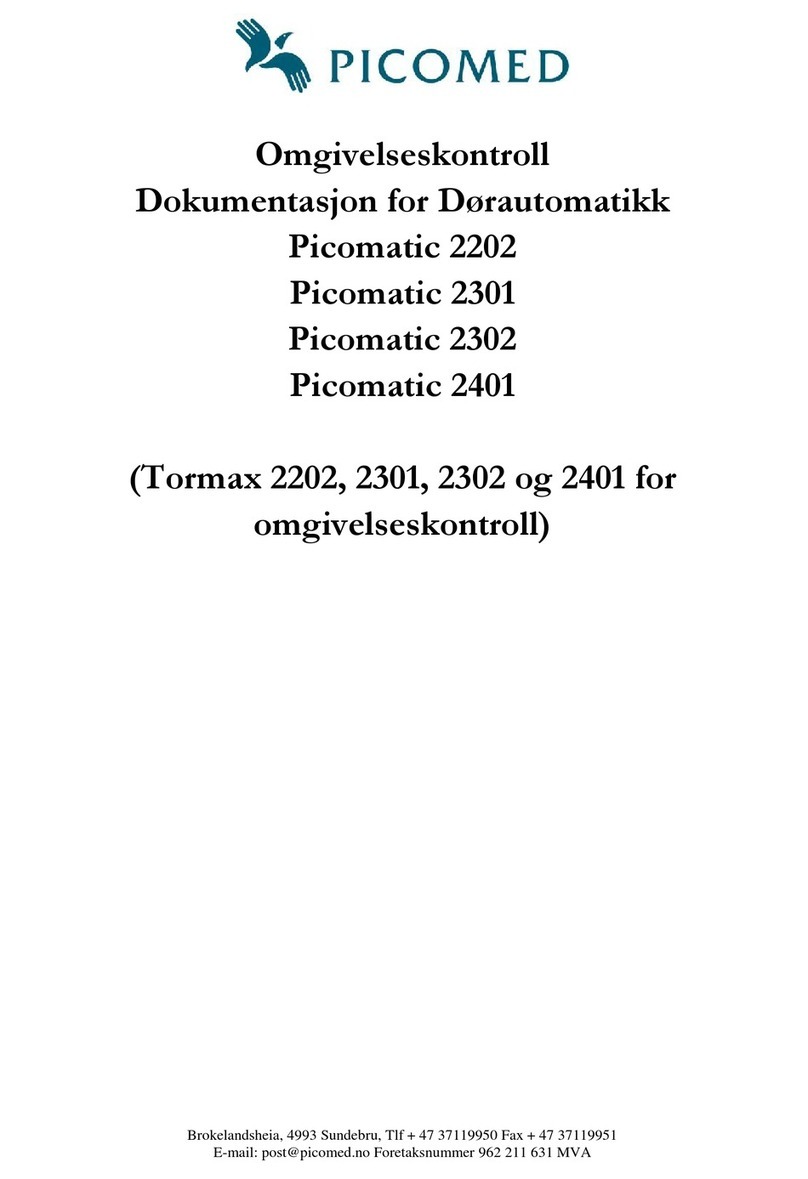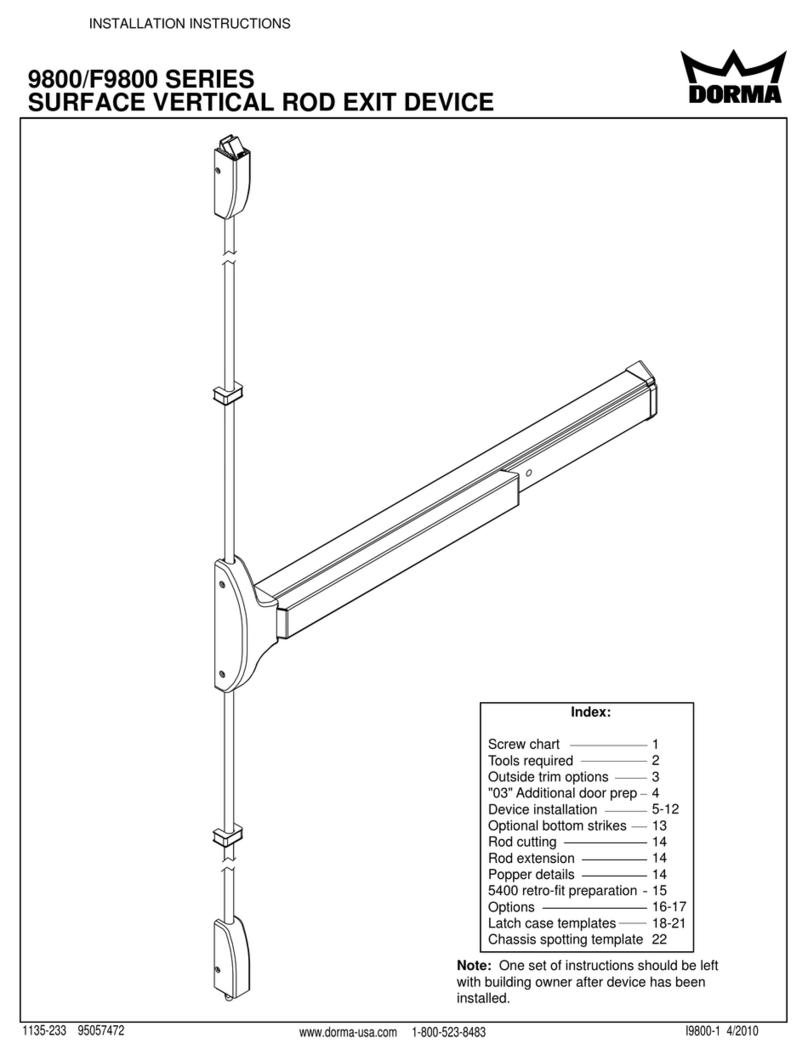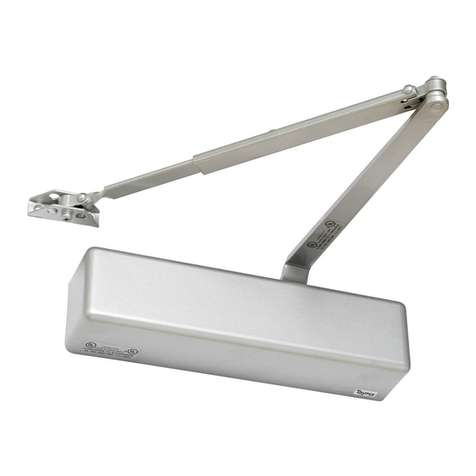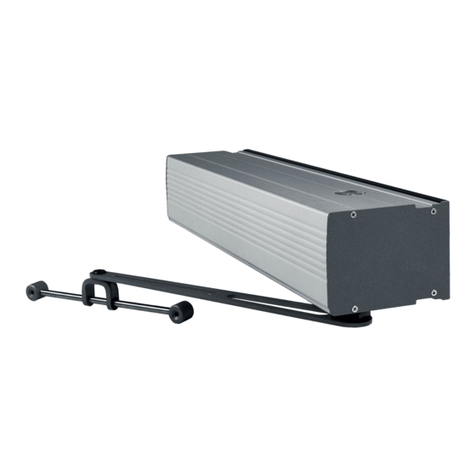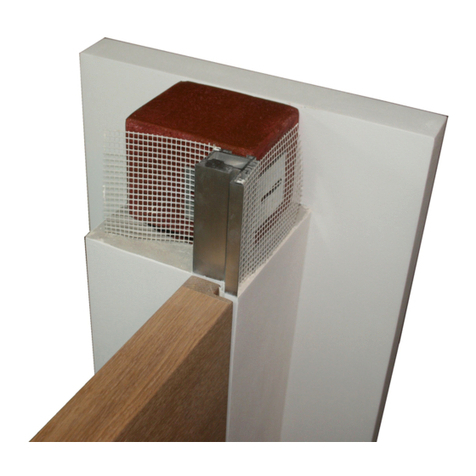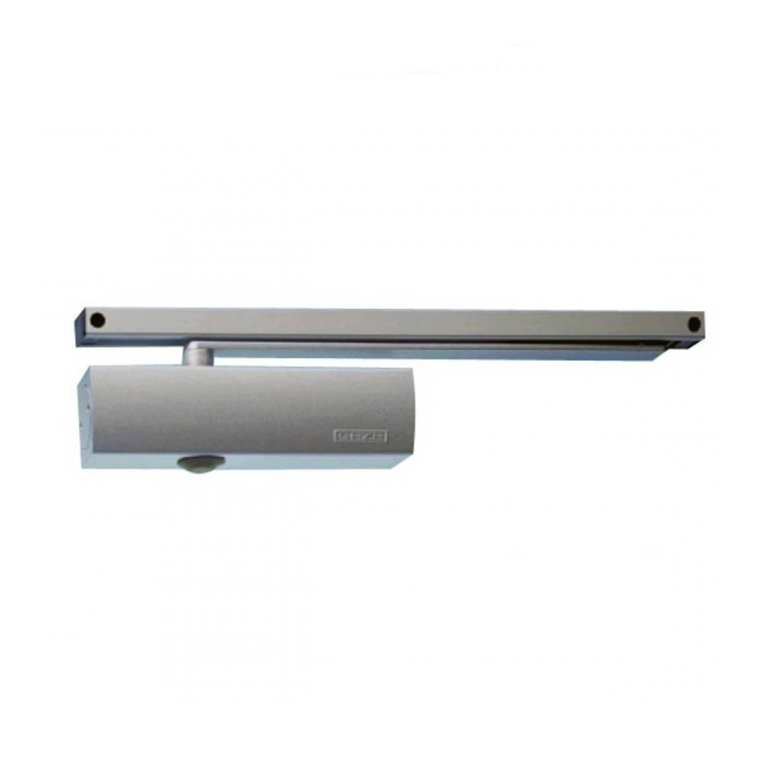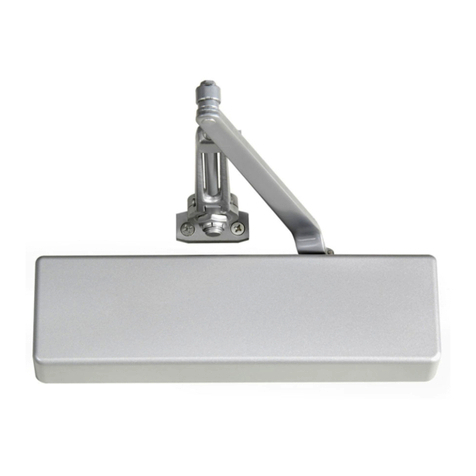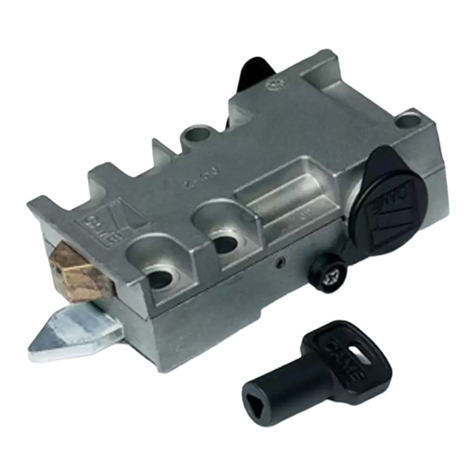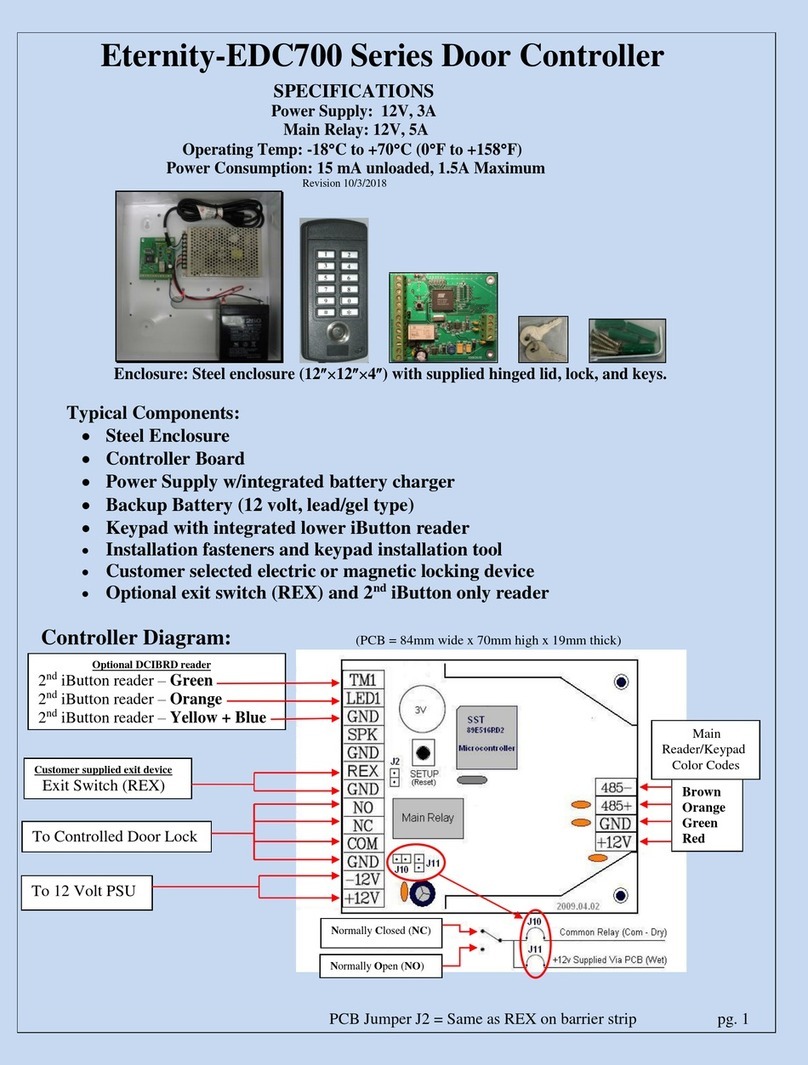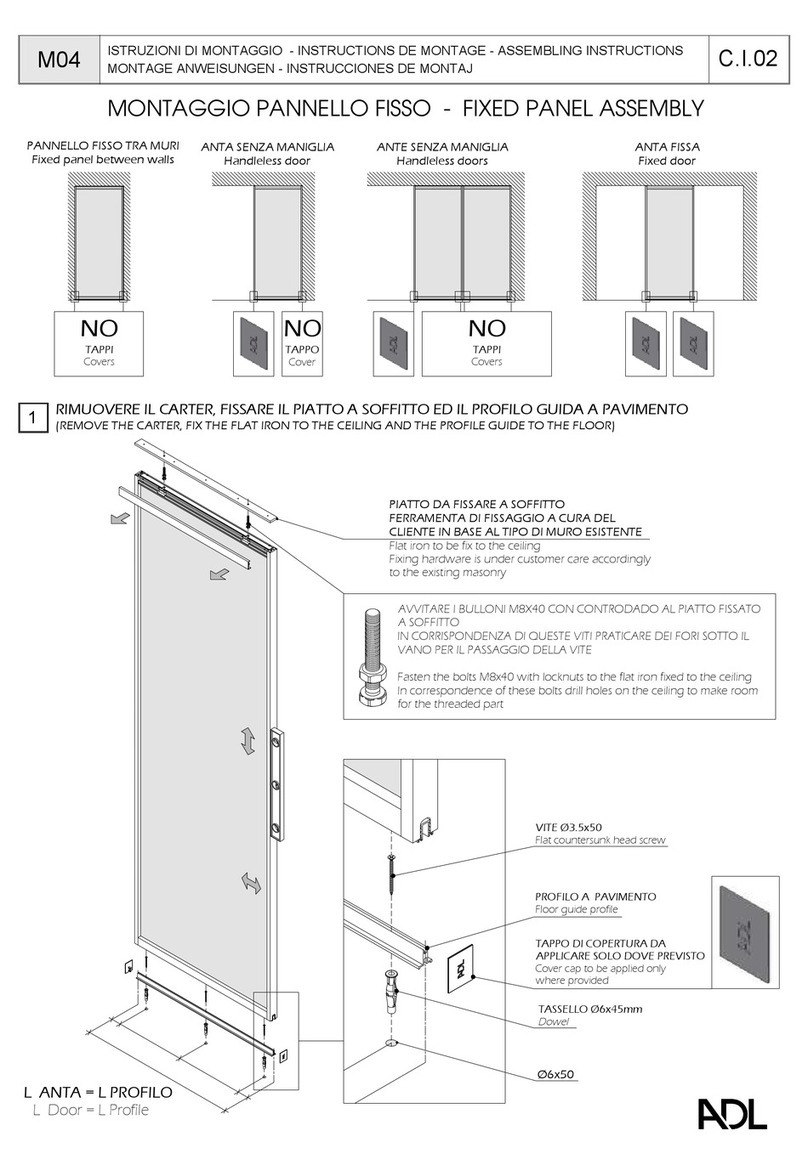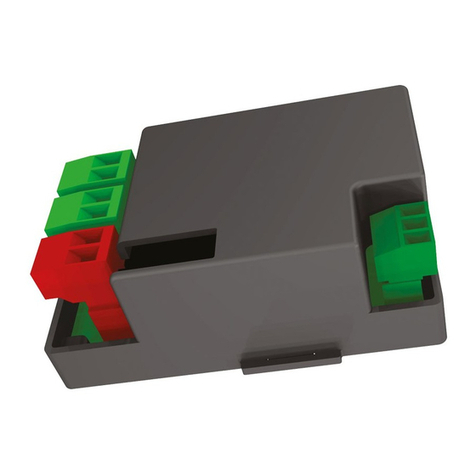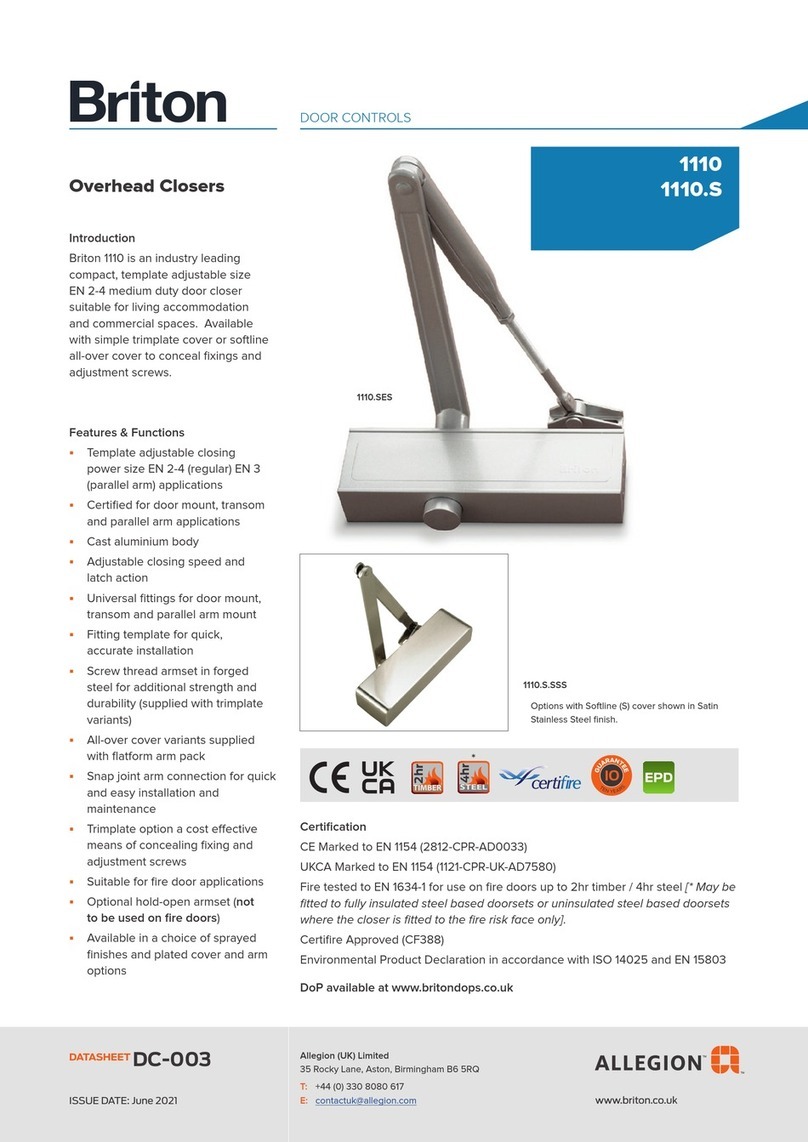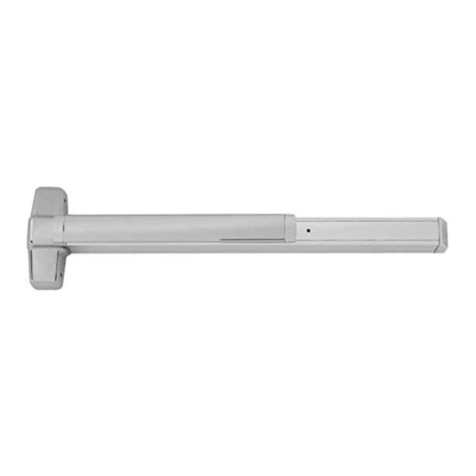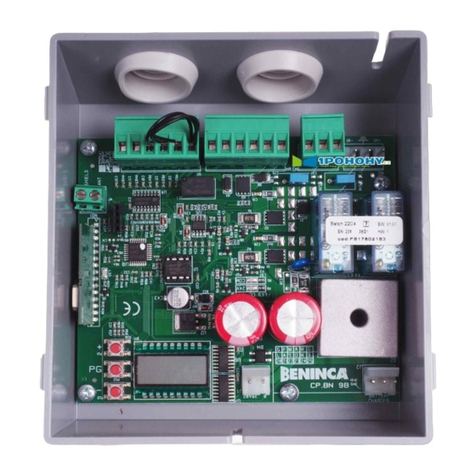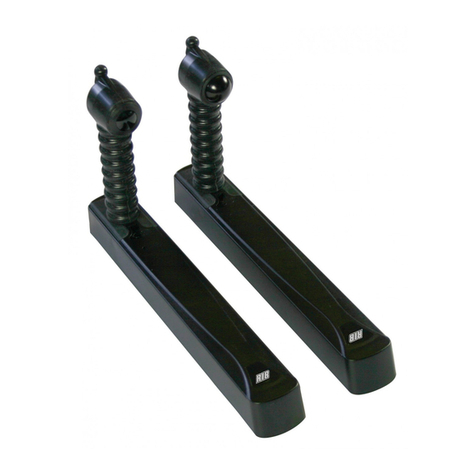Tormax 1102 User manual

T-1661 e 11.12.20
Translation of the original
instructions for use
Instructions for Use
For Automatic Swing Doors with Drive
TORMAX 1102 Swing Door Drive
TORMAX 1201 Swing Door Drive
Please follow the safety instructions in chapter 2!

2Instructions for Use TORMAX 1102, 1201 T-1661 e
First edition: 12.14, update 8.15, 11.20
We reserve the right to make technical changes.
Contents
1 General Information 3
1.1 Target Groups 3
1.2 Storage and Forwarding of the Manual 3
1.3 Area of Application 3
1.4 Explanation of the Symbols 4
1.5 Technical Data 4
2 Safety 5
2.1 Responsibilities 5
2.2 Use for the Purpose Intended 5
2.3 Improper use 5
2.4 Pre-conditions for the Operation of the System 6
2.5 Hazards and Risks 6
2.6 Checks 7
2.7 Decommissioning the System in the Event of a Fault 7
2.8 Disposal 7
3 System Overview 8
4 System Functions 11
4.1 Automatic Door Operation with Sensors 11
4.2 Door Leaf Protection 11
4.3 System with Full-Energy Mode 11
4.4 Systems with Low-Energy Mode 11
4.5 Semi-automatic Operation with “Push and Go” 11
4.6 Manual operation with Power Assist 11
4.7 Traffic Control 12
4.8 Automatic System Monitoring 12
4.9 Economy power mode 12
4.10 Electric Lock 12
4.11 Operation in the Event of a Power Failure 12
4.12 Operating Modes 13
5 Operation 14
5.1 Commissioning 14
5.2 Operation with the TORMAX User Interface 14
5.3 Setting Customer Parameters with the TORMAX User Interface 15
5.4 Operation with an Operating Mode Switch 16
5.5 Operation on Power Failure 17
5.6 Resetting the Panic Fitting 17
6 Procedure in the Event of a Fault 17
7 Maintenance 18
7.1 Cleaning 18
7.2 Functional Checks 18
7.3 Maintenance and Testing 18
8 Appendix 19
8.1 Fault Table 19
8.2 Check-List for Functional Checks 21
Declaration of Conformity 23

Instructions for Use TORMAX 1102, 1201 T-1661 e 3
1 General Information
1.1 Target Groups
• Operator of the automatic swing door. The operator is the person responsible for the operation and
maintenance of the system.
• Persons instructed by the operator to carry out certain duties, for example the servicing and main-
tenance of the automatic swing door.
1.2 Storage and Forwarding of the Manual
• Store the instructions for use in the vicinity of the automatic door system.
• If the manual has become illegible due to constant usage, reorder the instructions.
For download and print out see also: www.tormax.com
• When the door system is transferred or resaled to a third party, pass the following documents to
the new owner:
– This instructions for use
– Documentation concerning modification and repair work
– Proof of the regular examinations System test book T-879
1.3 Area of Application
Product name, door system: Automatic swing door (single or double-leaf)
Product name, door drive: TORMAX 1102 Swing Door Drive / TTX 1102
TORMAX 1201 Swing Door Drive
The door drives are defined in more detail by a 4-figure number:
Continuous numbering
Drive for swing door system
Increasing power
1 2 0 1
Door drive identification plate (example) with
the serial number: located on the drive under-
neath the cladding
Door system identification plate
(example): located on the side
panel of the drive.
Initial Commissioning
Swing Door System
Contact
System No.
Manufactured
TORMAX
WT-306 e 2.20
Next Service
DIN 18650-1:2010
4 3 4 0 12
For electrical connection values, please refer to
the operating instructions and the system test book.
000/000/00
MM.YYYY
DD.MM.YYYY
2019

4Instructions for Use TORMAX 1102, 1201 T-1661 e
<
1.4 Explanation of the Symbols
Warning (signal word)
Source of hazard (designates a possibly hazardous situation)
Possible consequences of non-observance
• Measures for averting danger.
Text which is highlighted in grey MUST be observed to ensure that the system operates perfectly.
Failure to observe these sections can cause damage to equipment.
Functions marked with this symbol are the factory setting. However, they can be reprogrammed
by a specialist.
Optional components which are not present in all systems.
1.5 Technical Data
Drive type Electromechanical swing door drive with DC motor
Control system Control unit MCU42
Mains connection 1 × 230 V | 10 – 16 A
1 × 115 V | 15 – 20 A
Power consumption TORMAX 1102: 6 … 210 W
TORMAX 1201: 6 … 235 W
Sensor supply 24V DC 1,5A
Protective class, drive IP20
Ambient temperature –20 °C to +50 °C
Fuse 5 AT
Drive weight
TORMAX 1102 11,2 kg
TORMAX 1201 11,8 kg
Noise emission level < 70 db (A), depending on door and substructure
Service life Tested to 1’000’000 cycles

Instructions for Use TORMAX 1102, 1201 T-1661 e 5
2 Safety
Warning
Important safety instructions
It is important to comply with these Instructions to ensure the safety of persons.
These Instructions must be kept in a safe place.
2.1 Responsibilities
Installation of the system: A specialist from a TORMAX sales partner
For instructing the operator: A specialist from a TORMAX sales partner
For operating the system: The operator or a person instructed by the operator
For maintenance and function control: The operator or a person instructed by the operator
For annual testing and approval: A specialist authorised by the manufacturer
Specialists are persons who have adequate knowledge in the field of power-operated doors as a result
of their specialist training and experience and who are so familiar with the relevant health and safety
regulations, guide-lines and generally recognised codes of practice that they are able to assess the
condition of power-operated doors with regard to the safety of their operation.
Maintenance of electrical parts must be carried out by a trained electrician.
2.2 Use for the Purpose Intended
The product including the associated components is designed for the automation of horizontally mov-
ing swing doors for pedestrian access doors. The drive must only be installed in a dry environment
inside buildings.
• It may only be used on fire protection doors once its suitability has been proven in accordance with
local regulations.
• Assembly, installation, repair and maintenance work and the commissioning of the drive must only
be undertaken my qualified persons.
• The swing door drive may only be operated by properly trained persons who must also follow the
Instructions for Use.
• The door system may be used by persons with impaired physical, mental or sensory capabilities
provided that they are either under the supervision of the person responsible for their safety that the
latter has instructed them on the safe use of the system and its potential risks.
• Children must be supervised to ensure that they do not play close to the system and do not operate
any available operating controls..
2.3 Improper use
The manufacturer will not accept any liability whatsoever for loss or damage caused by improper use,
failure to comply with the maintenance specification (see chapter 7) or unauthorised modification of
the system.
• Any conversion of the system (e.g. other user groups) is not permitted without a new risk assessment
(by a specialist) and the measures derived from it.
• Structural alterations in the danger area around the door system are prohibited without a new risk
assessment (by a specialist) and the measures derived from it.

6Instructions for Use TORMAX 1102, 1201 T-1661 e
• Modifications to the door system (e.g. different, heavier door leaves, different operating equipment
or sensor systems) may only be undertaken by a properly trained person who complies with the
technical limit values.
• Safety facilities (e.g. sensor technology, manual unlocking) must not be removed or disabled.
• User maintenance and cleaning of the system must not be undertaken by children.
Other improper uses (examples)
• Automatic doors with leaves moving vertically.
• Automatic doors with leaves moving in an inclined plane.
• Door systems incorporating a wicket door must not be automated.
• The drive must not be used as a drive for a wicket door.
• Automatic doors and gates located in transport equipment (e.g. motor vehicles or lifts)
• Use in abrasive and corrosive environments or in areas subject to the danger of explosions.
2.4 Pre-conditions for the Operation of the System
The door system was designed, installed and checked for functionality and safety by specialists prior
to hand-over to the operator. The company responsible for the system’s installation instructed the op-
erator on the system’s use and maintenance as well dangers associated with the system operation.
The operator has confirmed this by his signature in the system test book T-879. The provisions imposed
by law, health and safety and occupational health regulations for the avoidance of accidents and the
protection of the environment which are generally applicable in the country in which the system is
operated supplement the instructions for use.
• The staff responsible (see chapter 2.1) must have read and understood these Instructions before
commissioning or using the door system.
• Only use the system when it is in perfect working order. The operating conditions, inspection and
maintenance intervals stipulated by the manufacturer must be observed (chapter 7).
• Arrange to have any faults rectified immediately by a specialist.
2.5 Hazards and Risks
Depending on the system design and equipment,
there is a residual risk of crushing, shearing and
collision with limited force in the movement area of
the door leaf.
Warning
Danger through moving parts:
– in the area of all closing edges (especially hinge)
– in the region of the linkage lever
– when objects such as, for example, display shelves are erected in the direct proximity of
the moving part of the door leaf.
Warning
Hazards can arise due to deliberate damage, incorrect installation, defec-
tive sensors or sensors which are longer properly adjusted, sharp edges,
incorrectly mounted and defective casing or missing covers.
Danger for body and life, danger of injury
• Have system repaired by a qualified person
T1661_3
1
1
1
2
3

Instructions for Use TORMAX 1102, 1201 T-1661 e 7
2.6 Checks
The regular checks and examinations set out in Chapter 7 must be carried out as instructed by the
manufacturer.
2.7 Decommissioning the System in the Event of a Fault
If there is a fault the automatic swing door may only be taken out of service by a skilled person, the
operator or a person who is instructed to do so by the operator. This must be done on all occasions on
which the safety of persons could be compromised.
• Disconnect the door system from the power supply. All the poles are disconnected using a 3-pole
IEC-plug or another all-pole disconnection device (e.g. in the fuse box).
• If another power source (e.g. battery u) is available, it must be disconnected from the system by a
specialist.
• If the door is classified as an escape route or fire door according to local standards:
– Open the door manually and secure in the open position if it is installed in an escape route.
– Fire doors must never be secured in the open position even in emergencies.
See section 6 for rectification of faults.
2.8 Disposal
This system must be properly dismantled at the end of its working life. Its disposal must comply with
national regulations. We recommend that you contact a skilled person disposal company.
Warning
Electric voltage
Risk of injury by electric shock
• Disconnect the mains power supply to the installation before dismantling.
Warning
Aggressive acids
Risk of injury if you dismantle the battery module.
• Dispose of batteries properly.
Warning
Flying around parts
The tensioned spring represents a hazard when dismantling the drive.
• Before opening the casing, release the tension on the spring up to the stop.
Warning
Broken glass
Risk of injury when dismantling the door leaves.
• Take care when transporting the door leaves.

8Instructions for Use TORMAX 1102, 1201 T-1661 e
3 System Overview
System with standard linkage (1c) System with sliding lever (1c)
Ex. Installation on lintel Ex. Installation on door leaf Ex. Installation on lintel
Single-leaf door system (fig. with standard linkage)
Double-leaf door system (fig. with standard linkage)
T1661_16
1c 1c
1c
1c
1c
1c
T1661_16
1c 1c 1c
1c
1c
1c
T1661_16
1c 1c
1c
1c
1c
1c
10b
4a/4b
7b7b 6a
6b
3b3b
HKHK
outside
3b
3b
T1661_7e
7a 7a
5a
10a
NK NK
1a,b,d
3a 3a
1c 1c
inside
2b
2c 4a 4b 4c 4d
5b 8b
8a
8c
9
1a,b,e
2a
2a
10c,d
7b
6a
6b
10a 3b
3b
HK
GK HK
GK
T1661_1e
7a
5a
1a,b
3
1c
10b
10c,d
4a 4b 4c
5b 8b
4a/4b
8a
8c
9
inside outside
2a
HK: Main closing edge
NK: Secondary closing edge
GK: Counter closing edge

Instructions for Use TORMAX 1102, 1201 T-1661 e 9
1 Drive a) Motor and spring unit
b) MCU42 control system with monitoring system, power limitation and
permanent diagnosis.
£Controlled closing function of the door in power-off condition
£Controlled opening function in power-off condition
c) Linkage / sliding lever
d) Primary drive
e) Secondary drive
2Drive accessories a) £Emergency power supply via the battery unit
b) £Mechanical door coordinator for double-leaf doors
c) £Driver flap to the mechanical door coordinator
3 Door leaves a) Swing leaf with main closing edge (HK) and secondary closing edge (NK) *
b) £Finger protection to enhance the safety of the secondary closing edge *
4Operating controls a) £User interface with 5 operating modes and fault display
b) £Operating mode switch with 3 positions.
c) £Lock for the user interface
d) £Switch for 1-leaf operation *
5Internal activators a) With automatic activation b) With manual activation
£Radar with/without direction recognition * £Push button *
£IR motion detector * £Contact-free button *
£Contact mat * £Button for passage with bed *
6External activators a) With automatic activation b) With manual activation
£Radar with/without direction recognition * £Key switch
£IR motion detector * £Card reader *
£Contact mat * £Remote control *
£Button for passage with bed *
7Safety sensors a) £Presence sensor safeguarding the swing area when closing
b) £Presence sensor safeguarding the swing area when opening
8Emergency systems a) £Power switch / fuse *
b) £Emergency-off *
c) £Fire alarm system *
9Output message £Bell / gong *
£Door status *
10 Lock a) £Electrical door opener *
b) £Door handle *
c) £Mechanical door lock *
d) £Electical lock *
£Depending on the system’s equipment
* Provided by the installation company.
The company installing the system must select and install suitable components in accordance with the
product standard EN16005.

10 Instructions for Use TORMAX 1102, 1201 T-1661 e
Block Diagram
All work on the mains power supply cable and the system's cabling must only be undertaken by an
authorised and properly trained person who must refer to all necessary documents.
Single-leaf door system
Double-leaf door system
Drive unit with control system
T1661_12e
230 VAC
115 VAC
User interface
5 operating modes
Operating mode switch
3 operating modes
Battery unit
Key switch
Electric door opener/
Electric lock
Building management
system
Lock user interface
Combined sensor
inside
Opening activator
inside
Sensor safeguarding
second. closing edge
Combined sensor
outside
Opening activator
outside
or
Drive unit with control system
Secondary drive
230 VAC
115 VAC
Battery unit
Switch single leaf
operation
Sensor safeguarding
second. closing edge
Drive unit with control system
Primary drive
T1661_15e
230 VAC
115 VAC
User interface
5 operating modes
Operating mode switch
3 operating modes
Battery unit
Key switch
Button for passage
with bed
Lock user interface
Combined sensor
inside
Opening activator
inside
Sensor safeguarding
second. closing edge
Combined sensor
outside
Opening activator
outside
or
Building management
system
Combined sensor
inside
Combined sensor
outside
Electric door opener/
Electric lock
Electric door opener/
Electric lock

Instructions for Use TORMAX 1102, 1201 T-1661 e 11
4 System Functions
The operator of the door system is responsible for ensur-
ing that the automatic swing door is freely accessible at all
times. The operator must particularly ensure that the swing
area of the door leaves is not obstructed by any objects.
4.1 Automatic Door Operation with Sensors
When operating automatically (operating mode AUTOMATIC) the door is automatically opened from
both sides by sensors when a person approaches. A key switch uor card reader unormally allows
access from outside when the door is in operating mode EXIT or OFF. The door unlocks u, opens and
closes again as soon as no further sensors are activated after a hold-open time which is set sepa-
rately.
Double-leaf doors open at the same time or, in the case of overlapping door leaves, in sequence. Clos-
ing must be in the correct closing sequence and, for reasons of safety, one after the other.
4.2 Door Leaf Protection
The safety devices are selected and installed by the installation company in line with general and
country-specific standards, guide-lines and requirements.
4.3 System with Full-Energy Mode
The door leaves are equipped with safety sensors on the leaves. The safety sensors prevent a person
in the operating radius of the leaf from being hit by the leaf. If one of the safety sensors should fail, the
system switches to safety mode. The door can still be opened but only manually. In the case of low risk
systems, the system switches to emergency mode. The door leaf still moves but only slowly and in
Low-Energy mode. If the safety device fails in the closing direction, the door remains open for 30 sec-
onds.
4.4 Systems with Low-Energy Mode
Hazards due to impact and crushing are minimised by restrictions on speed and force. Thus the system
provides a high degree of safety.
The system offers maximum ease of use and safety if it is equipped with additional safety sensors.
4.5 Semi-automatic Operation with “Push and Go”
Instead of having sensors the door can be manually pushed open. After being detected by the control
system, the door opens automatically and closes again.
4.6 Manual Operation with Power Assist
In operating mode P “Manual operation” or depending on the exact setting in AUTOMAT, the door can
be easily opened manually with “Power Assist”. After opening, the door remains in the hold open posi-
tion before it closes automatically using little force.
Depending on the configuration, “Power Assist” can be activated in advance for a limited period using
a button, door trap sensor or a motion detector. In this case the door can be easily opened with very
little effort.
T1540_12

12 Instructions for Use TORMAX 1102, 1201 T-1661 e
4.7 Traffic Control
Movement through the door can be allowed in only one direction if desired (operating mode EXIT) or
completely blocked (operating mode OFF).
Double-leaf door systems can also be operated as single leaf doors by means of the single leaf op-
eration switch. In this case both doors can only be opened by means of the key switch or the “bed
movement” switch.
4.8 Automatic System Monitoring
The control system monitors the safety sensors by a cycle of active tests. The control system also
conducts continuous internal system tests. If a safety-related component should fail, the system auto-
matically switches into a safe condition. At the same time the fault number is displayed on the user
interface. The operating mode currently displayed also flashes. You can find further information on this
subject in section 6 “Procedure in the Event of a Fault”.
4.9 Economy Power Mode
Economy power mode is activated as standard. This mode consumes less power in the non-operative
state. The illumination on the user interface and most sensors are automatically switched off when not
in use.
4.10 Electric Lock u
The system can be locked in the closed position by means of an electric lock u.
4.11 Operation in the Event of a Power Failure
Depending on the equipment installed, the following functions are possible:
– Controlled closing using the integral spring. The door can be opened manually by means of the
door handle (unlocking).
The door then closes again in a controlled manner using the integral spring.
– Continued operation for a certain period in the current operating mode by means of a battery unit u.
– Unlocking and opening of the door from outside by means of a key switch and the battery unit u.
The closing sequence is maintained in double-leaf door systems by the use of a mechanical door
coordinator.

Instructions for Use TORMAX 1102, 1201 T-1661 e 13
4.12 Operating Modes
The automatic door system can be operated with the TORMAX user interface u(5 operating modes
and status display) or with an operating mode switch u(3 operating modes).
Operating Mode OFF
The internal and external sensors are disregarded. The door is mechanically held in the closed position
and locked using an electric lock u. Access is only possible using the key switch or if the door is
manually unlocked using a key or the door handle is used to open the door manually. The door can still
be used for 5 seconds after selecting operating mode OFF. The door then locks at the end of this pe-
riod as soon as it is closed. The transition is signalled on the user interface by the flashing display of
operating mode OFF.
Operating Mode AUTOMATIC
The operating mode AUTOMATIC is normally used during the day. The door opens automatically through
the inside and outside sensors. The door can behave differently depending on the settings programmed
during commissioning:
“Push-and-Go”
If the door is manually pushed in the opening direction, it reacts as if to a command to open: it opens
automatically, waits for the hold-open time and then closes.
Systems with an electric door lock u
The lock unlocks on every opening impulse. For opening by “push-and-go”, the door lock must be un-
locked manually with the lever handle. In this operating mode the door lock can also be permanently
unlocked depending on the setting programmed at the time of commissioning.
Operating Mode EXIT
Operating mode EXIT is normally used for the period before the shop or office closes. The door will
only open automatically when activated by the internal sensor. When the door opens the external sen-
sor is also monitored for safety reasons. The open position is determined by the preceding selection
of the operating mode AUTOMATIC. Additionally the door can be locked automatically by the door
lock u.The door lock can be permanently unlocked in this operating mode in case of need.
Operating Mode OPEN
The door opens and remains open. The open position is determined by the preceding selection of the
operating mode AUTOMATIC. The door opens again on receiving the next open impulse or when
changing the operating mode to OFF and back again to OPEN.
Operating Mode Manual Operation
The door leaf can be freely moved. This operating mode can be used for temporarily shutting down the
door. On each opening command In this operating mode the door lock is unlocked during 10 s. After a
single leaf of a double-leaf door system has been opened manually, the closing sequence is maintained
mechanically by means of a mechanical door coordinator. If there is no mechanical door coordinator,
the door leaves can be opened manually independently of each other without regard to the overlap on
the door leaves.
Single-Leaf Operation Switch
– Secondary leaf ON: If an opening command is given or in the event of Push & Go, both leaves always
open.
– Secondary leaf OFF: If an opening command is given via the internal or external sensors or by Push
& Go, only the primary leaf. If an opening command is given by the “passage for beds” button or the
key switch, both doors are opened.
P

14 Instructions for Use TORMAX 1102, 1201 T-1661 e
5 Operation
The automatic swing door may only be operated by a skilled person, the operator or a person in-
structed by the operator.
5.1 Commissioning
Before switching on the mains power supply:
• Unlock the optional mechanical door lock.
• Check that the movement area of the door leaves is free from obstructions such as racks, plant
containers, umbrella stands ect.
• Switch on the mains power supply and select operating mode AUTOMATIC 1, for example.
The first movement after switching the power on for the first time is slow and H67/ H62 is dis-
played. The control system is checking the door leaf’s travel distance and defining the end position.
The door is now ready for operation.
5.2 Operation with the TORMAX User Interface u
TORMAX User Interface Lock ufor User Interface
www.tormax.com
1
2
3
4
1
1
0
T1427_4
T1661_2e
OFF
AUTOMATIC
not assigned
OPEN
EXIT
Operating mode
symbols
Manual operation
Door electrically
locked
Selector key 2
Selector key 1
Unlocking of Operating Unit
The operating unit can be protected against unauthorized access by way of the lock uor the code lock.
• Unlock lock = position 0
or
• Enter code … / … / … using operating unit. The code can be determined by the engineer.
Example with code 3 / 3 / 3. Press upper selection button 3 times, then press the lower selection but-
ton 3 times and the upper selection button within 15 s . In case of entering wrong code: Wait at least
5 s . After successfully entering the code, the operating unit will be released within 60 s. The type of
operation can be adjusted. Access will be automatically blocked again for 60 s after the button has
been pressed for the last time.
Selection of Operating Modes
• Press selector keys 1 or 2 briefly. The corresponding operating mode symbol is illuminated.

Instructions for Use TORMAX 1102, 1201 T-1661 e 15
Fault Display
E.g. H31 or E42 See section 8 for the meaning of the display.
Resetting the System
• Press the selector key 2 for at least 5 seconds.
The software is restarted. On double-leaf door systems the software is restarted automatically on both
drives.
5.3 Setting Customer Parameters with the TORMAX User Interface
The company undertaking the installation reserves the right to restrict access to all or some of the
customer parameter settings. If the user interface is in an area accessible to the public it must be
protected against third party access by a “code lock” or a “lock for the user interface”.
Access level “U” for customer parameters
Enter the three digit code for parameters
• Similarly, select and confirm the second and the third characters of the code.
If “C” appears, access is blocked. Parameters cannot be re-set in this case.
T1661_10e
Uappears, ready for programming
Confirm with
key 2
P
T1661_11e
Zero appears as first digit of code
P
Enter first code
digit with key 1
Confirm with
key 2
T1661_9e
Indication of operating mode
Press keys 1 and 2
simultaneously until
«U» appears
P

16 Instructions for Use TORMAX 1102, 1201 T-1661 e
Parameters for displays
01 Drive type (1 = 1102, 2 = 1201)
042 Firmware version
043 Number of cycles
044 Number of operating hours
046 Control address for network
Parameters for settings
10 0…E Hold open time for activator inside/ outside
0 / 1/ 2 / 3 /4 / 5 / 6 / 8 /10 /12.5 /15 /17.5 /20/40/ 60 s11 0…E Hold-open time button e.g. for beds
12 0…E Hold-open time for key switch
13 0…9 Delay for operating mode OFF (selection via
user interface)
1/ 3 /5 / 7.5 /10 /15 /20 /30 /45 / 60 s
14 0…9 Bell active time 0 / 0.5 / 1 / 2 / 3 / 4 / 5 / 6 / 8 / 10 s
15 0…E Hold open time for Power Assist 0/1/2/3/4/5/6/8/10/12,5 /15 /17,5 /20 /40 / 60 s
16 0…E Hold open time for Push and Go
20 0…6 Opening speed 10 … 100 %
21 0…6 Closing speed
301…3/6 Power limit when opening
Maximum depends on the drive type
311…3/6 Power limit when closing
321…3/6 Power limit when closing before the door is
closed
38 0…6 Starting angle for Push & Go / Power Assist 1/ 2 / 3 / 5 / 8 / 12 / 16 degrees
39 0…5 Starting angle for Push & Close Maximum / 8 / 10 / 12 / 14 / 16 degrees
80 0…2 Bell trigger Activator outside / activator inside / key switch
81 0…4 Button press time (detection delay for activator) 0/1/2/3/5
91 0…4 Code lock for user interface Switched off / code 111/... 222 /… 333 /…123
Command
040 Software reset
5.4 Operation with an Operating Mode Switch u
Resetting the System
– Change the operating mode in the event of a fault with code E31 – E38 or E51
or
– Cut off power supply to the system for at least 5 seconds (systems without battery unit only).
OFF
AUTOMATIC
OPEN
T1305_4

Instructions for Use TORMAX 1102, 1201 T-1661 e 17
5.5 Operation on Power Failure
Opening a Door using a Key Switch uwith aBattery Unit u
• Activate the key switch and hold in place for at least 5 seconds, then turn back the key.
The battery is activated using the “wake up” function.
The key switch must not remain permanently in the “on” opposition.
The door is unlocked and opened.
The battery switches off again after the time programmed by the installation engineer or
when the battery is fully discharged.
If required, the operating mode can be changed on the user interface during the wake-up.
5.6 Resetting the Panic Fitting u
• Select operating mode OFF (operating mode switch , user interface ) or disconnect the drive from
mains (installation switch, mains plug).
• Push the door leaf back into the initial position.
• Choose operating mode AUTOMATIC or switch on drive respectively.
6 Procedure in the Event of a Fault
The automatic swing door drive may only be operated by a specialist, by the operator or by a person
instructed by the operator.
Faults are evident from abnormal door behaviour and/or as a fault display on the user interface. Fault
displays on the user interface take the form of a flashing “E” or “H” followed by two figures.
H = notification > the system can continue to be used.
E = fault > the system is stationary.
Some faults or notifications can be rectified by restarting the door drive with a software reset and/or
briefly (> 10 s) disconnecting the system from the power supply.
Fault Display and Reset Using the TORMAX User Interface
See the table in section 8.1 for an overview of the fault displays.
Browse through the fault display using selector key 1
(to display several faults).
1. Reset the fault display, press selector key 2 (downwards) briefly.
2. Software reset: press the key for 5 seconds.
Reset of the Fault with the Operating Mode Switch
Software reset in the event of a fault: change the operating mode.
Reset of the Fault by Disconnecting the Power Supply
If the system does not have a battery unit, disconnect from the power supply for about 10 seconds.
If this does not reset the fault or if it re-occurs after a short time, you must arrange for the fault to be
rectified by a skilled person from your TORMAX dealer. In this case note the fault number and inform
the dealer. See the last page or the service tag on the system for the dealer’s address.
T1305_5
T1305_4

18 Instructions for Use TORMAX 1102, 1201 T-1661 e
7 Maintenance
The system was tested and approved by a skilled person before initial commissioning. The manufac-
turer recommends that you conclude a service contract in order to maintain the value of your system
for as long as possible as well as to ensure the system operates reliably and safely for a long time.
Only genuine TORMAX spare part should be used. The manufacturer accepts no liability if you fail
to observe this requirement. Original spare parts and original accessories guarantee the safety of
use in accordance with norm EN 16005.
Warning
Possible risk of injury!
Entrapment of limbs can lead to serious injury.
• The drive must be disconnected from all power sources, including batteries during clean-
ing maintenance and replacement of parts.
7.1 Cleaning
• Clean casing parts, the user interface and door leaves with a damp cloth and a commercial cleaner.
7.2 Functional Checks
• Check the door system's function and safety devices at least every 3 months.
This will ensure that faults or hazardous changes in the system are detected at an early stage. See
chapter 8.2 “Check-list for Functional Checks” for items to be checked.
• You should arrange for any defects detected during the routine checks to be rectified immediately by
a TORMAX dealer (see the last page of this Manual for the address).
Warning
Potential switching malfunction in the automatic swing door.
Potential hazards – injury caused by impact or crushing.
• Secure the area around the door while checking the door's functions.
7.3 Maintenance and Testing
Maintenance and testing should only be carried out by a trained specialist following the manufacturer’s
instructions.
Maintenance Interval
The maintenance interval depends on the frequency of use but the system must be maintained
at least once per year.
Scope of the Maintenance Work
The content of the maintenance work is specified by the manufacturer in an inspection list.
System Test Book
The test findings are recorded after the test in the system test book. The operator must keep it in a safe
place.

Instructions for Use TORMAX 1102, 1201 T-1661 e 19
8 Appendix
8.1 Fault Table
For the procedure in the event of a fault, see chapter 6.
System Behaviour No. Cause Remedy/ Rectification
The door stops when
opening.
H31 Electronic obstacle recognition
caused by persons, wind pressure
and ventilation when opening.
Remove the obstruction.
Avoid drafts.
Door reverses when clos-
ing.
H32 Electronic obstacle recognition
caused by persons, wind pressure
and ventilation when closing.
Remove the obstruction.
Avoid drafts.
The door stops repeat-
edly when opening.
The door stands still.
H33 Electronic obstacle recognition on
opening in the same position by
stationary obstacle.
Remove the obstruction.
The door stops repeat-
edly when closing.
The door stands still.
H34 Electronic obstacle recognition on
closing in the same position by sta-
tionary obstacle.
Remove the obstruction.
Search run notified. H62
H67
Search run of the door after a reset
or after power recovery.
Allow the search run to travel its full
course.
Door remains open or is in
operation again.
H71 System is in battery operation. Pause / ensure mains power supply
is connected.
Note in the event of el-
evated motor load.
H74 Drive is heavily loaded in the open
position by a soft stop or wind
load.
Remove the obstruction in the re-
gion of the open stop. Avoid wind
load.
The door remains open
or closed. The door
moves slowly.
H...
H0..
H1..
H2..
H4..
Problem with commissiong data. Have commissioning / repair car-
ried out by a specialist.
Door remains closed. –
E11
E12
Operating mode for example OFF,
EXIT or P. The door is prevented
from moving by the lock.
Motor lock will not unlock
will not lock
E.g. select operating mode AUTO-
MATIC. Unlock the lock. Push the
door closed briefly.
Prevent wind load on the door leaf.
Remove obstruction in the closed
position area.
The door remains open. – Operating mode OPEN or the door
is obstructed in the open position.
E.g. select operating mode AUTO-
MATIC. Remove the obstruction.
The door remains closed.
The door moves slowly.
E31 The safety facility in the opening
direction is permanently active
(>1 minute) or defective.
Remove objects from within the
range of the sensor(s).
The door remains open
or closed. The door
moves slowly.
E32 The safety facility in the closing di-
rection is permanently active
(>1 minute) or defective.
Remove objects from within the
range of the sensor(s).
The door does not open
or does not close.
E33 The safety facility for the swing area
is permanently active (>1 minute) or
defective.
Remove objects from within the
range of the sensor(s).
The door does not open
or does not close.
E34 The stop safety facility is perma-
nently active (>1 minute) or defec-
tive.
Remove objects from within the
range of the sensor(s).
The door opens slowly. E35 The safety facility in the opening
direction is permanently active
(> 1 minute) or defective.
Remove objects from the sensor
area.

20 Instructions for Use TORMAX 1102, 1201 T-1661 e
System Behaviour No. Cause Remedy/ Rectification
The door closes slowly. E36 The safety facility in the closing di-
rection is permanently active
(>1 minute) or defective.
Remove objects from within the
range of the sensor(s) and/or per-
form reset.
Tür öffnet mit Niederen-
ergie (evtl. langsamer)
E37 The safety facility in the opening
direction is permanently active
(>1 minute) or defective.
Remove objects from within the
range of the sensor(s) and/or per-
form reset.
Tür schliesst mit Nieder-
energie (evtl. langsamer)
E38 The safety facility in the closing di-
rection is permanently active
(>1 minute) or defective.
Remove objects from within the
range of the sensor(s) and/or per-
form reset.
The door remains open. E41
E42
E43
Activator inside > 1 min. active
Activator outside > 1 min. active
Key switch > 1 min. active
Reset key switch
Get sensor adjusted by an expert.
The door remains open. E45 Emergency opening is active for
> 1 minute
Reset the command from the higher
ranking system.
The door remains closed. E46 Emergency closing is active for
> 1 minute
Reset the command from the higher
ranking system.
The door remains closed. E47 Blocking switch active for
> 1 minute
Reset the command from the higher
ranking system.
The door remains open. E48 ”Beds“ sensor active for > 1 minute. Reset the switch for “passage with
beds”.
The door stands still. E49 Power Assist Pre-release >1 min.
active
Reset switch for “Pre-release”.
The door stands still. E51 Encoder/motor defective. Have the system repaired by a
specialist.
The door stands still. E61
E62
E63
Power supply is overloaded or volt-
age too low.
Get the power supply and connec-
tions checked by a skilled person.
The door stands still. E64 Drive/control system is overheated. Wait for the automatic reset after
the door/control system has
cooled.
Protect from direct sunlight.
The door stands still. E66 Motor or output stage defective. Wedge the door open in the open
position or disengage the linkage.
Switch off the power supply.
Arrange for the system to be re-
paired by a specialist.
The secondary door leaf
remains motionless.
E99 Fault on the secondary drive. Arrange for the system to be
checked by a specialist.
The door stands still. E..
E0..
E2..
Control system shut down for
safety reasons.
Perform a software-reset.
Arrange for the system to be re-
paired by a specialist.
Other manuals for 1102
2
This manual suits for next models
1
Table of contents
Other Tormax Door Opening System manuals



